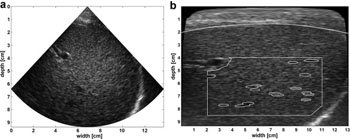Quantitative Ultrasound Helps Stage Fatty Liver
By MedImaging International staff writers
Posted on 17 Feb 2016
A new study suggests that computer-aided ultrasound could be used to stage hepatic steatosis, with a high correlation to magnetic resonance imaging (MRI) spectroscopy.Posted on 17 Feb 2016
Researchers at Radboud University Medical Center (Nijmegen, the Netherlands) conducted a pilot study in 14 patients on long-term home parenteral nutrition using a phased array ultrasound transducer connected to a calibrated ultrasound machine, with the radio frequency (RF) data converted into conventional B-mode images with the aid of computer software. All patients were also subjected to proton MRI spectroscopy measurement of liver fat content for reference.

Image: Original B-Mode image next to back scan-converted B-mode image with interactively drawn fat layer contour (white dotted line); initial fixed region of interest (white rectangle); automatic segmentation within region of interest (white ellipses) (Photo courtesy of Ultrasound in Medicine & Biology).
The results showed that computer-aided ultrasound parameters, similar to those in a previous validation study in cows, demonstrated significant correlation with fat content as measured by MRI spectroscopy, with the most significant parameters being residual attenuation coefficient and lateral speckle size. According to the researchers, the method shows promise as a noninvasive, easy, and inexpensive alternative to invasive biopsies or expensive MRI spectroscopy techniques. The study was published in the March 2016 issue of Ultrasound in Medicine & Biology.
“Patients on home parenteral nutrition are at risk for developing liver dysfunction, which is due partly to the accumulation of lipids in the liver and may progress to end-stage liver disease with overt liver failure,” said lead author Gert Weijers, PhD, of the Radboud Medical Ultrasound Imaging Centre (MUSIC). “Therefore, a timely diagnosis with easy access to repeated assessment of the degree of liver steatosis is of great importance.”
Steatosis in the liver, when it is not due to excessive alcohol use, is most often related to insulin resistance and to metabolic syndrome, and as a result may respond to treatments originally developed for other insulin-resistant states, such as diabetes mellitus type 2. Steatosis is also the most common liver disease of high-yielding dairy cattle during early lactation, making it a suitable animal model for studying liver fat accumulation.
Related Links:
Radboud University Medical Center














